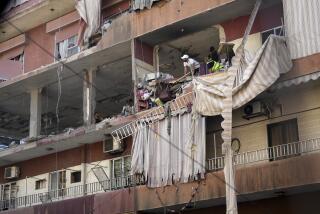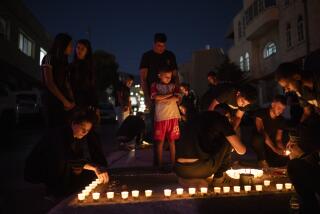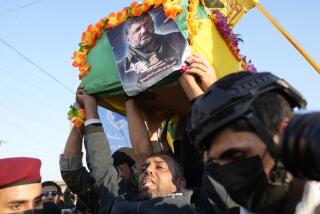Risky Fight for Baghdad Nears
WASHINGTON — As U.S. and British forces draw closer to Baghdad and a conclusive battle, they plan to rely heavily on air attacks to break the resistance of Iraqi forces, yet will have little choice but to send soldiers into the city’s dangerous streets.
Military commanders believe that with coordinated air and ground attacks on key targets -- such as command centers, supply depots and communications facilities -- they can end the war without a prolonged siege or house-to-house fighting that could kill thousands.
The Pentagon intends to soften up Iraqi forces in the city with airstrikes, then send in raiding parties of armored units, Special Forces and light infantry to finish off their targets. Yet despite the U.S. technological edge, officials acknowledge there are enormous risks in sending ground forces against Iraqi snipers and the heavy weapons that are likely to be concealed in the urban maze of Baghdad.
The outcome of the entire campaign may ride on the choices the military makes now in Baghdad, where the Iraqi regime has apparently chosen to make its stand. U.S. leaders are determined to end the war as soon as possible, yet they know they cannot afford the kind of high casualties or widespread destruction that would heighten the world’s sympathy for Saddam Hussein’s regime.
The leading edge of the forces -- the Army’s 3rd Infantry Division -- was within 100 miles of Baghdad on Sunday, and could reach the outskirts of the city as early as Tuesday. That suggests an assault on the capital toward the end of the week. It will likely be the most dangerous part of the war.
“This is going to get a lot harder,” Gen. Richard B. Myers, chairman of the Joint Chiefs of Staff, said in a television interview. “Anybody that thinks this is going to be quick and easy is wrong.”
Although thousands of Iraqi troops have surrendered, U.S. commanders have already seen evidence that many of the more loyal forces arrayed around Baghdad intend to carry out the bloody fight that Saddam Hussein has promised.
Five divisions of Hussein’s Republican Guard are encircling Baghdad, and U.S. forces already have exchanged fire at the city’s southern approaches with the guard’s well-known Nebuchadnezzar and Hammurabi divisions.
In another ring inside them are the roughly 15,000 members of the Special Republican Guard, a paramilitary and security force. Also likely to fight are many members of the Special Security Organization, a hard-core security force, and the Saddam Fedayeen, a group of fanatical loyalists specially trained in street fighting.
U.S. commanders continue to hope that they can break the morale of these forces and negotiate a surrender before the final fight begins. . Officials have signaled in the past that there could be a pause after the U.S.-led forces reach the outskirts of the city to allow for some final negotiations.
“There are lots of ways this thing could end without conflict inside Baghdad,” Myers said Sunday.
U.S. forces are also likely to pause at the edge of the city while troops get into position and additional reconnaissance is conducted to pinpoint key targets, notably mobile forces in the field.
And they will be intensifying the pace of their bombardment. U.S. warplanes, including AV-8B Harriers, F-14s, F-15s, F-16s and F-18s, have been bombing the city at a pace of about 500 missions a day, according to military analyst William H. Arkin. The rate may be increased to 700 if two additional U.S. aircraft carriers move within range.
Arkin believes the main assault on the city will be made by the Army’s 3rd Infantry and 101st Airborne divisions, driving from the west, around the Saddam International Airport. This approach is the shortest distance from the desert to the center of the city, and the airport has three large building complexes that U.S. forces could use as a staging area, he said.
The 1st Marine Expeditionary Force and the British 7th Armored Brigade will attack the city from the east, he said.
As they approach the city, U.S. commanders also fear they may be at greater risk of attack by chemical and germ weapons. Military leaders believe Hussein might have husbanded them for the last battle, where he could potentially use them with maximum effect against large stationary U.S. and British forces.
“As we move closer to Baghdad, U.S. forces become more concentrated and they become targets for weapons of mass destruction,” said William Schneider, chairman of the Defense Science Board, an influential Pentagon advisory panel.
The chemical shells would most likely be delivered in rockets like the 122-millimeter shells discovered by United Nations weapons inspectors, he said.
To destroy targets in the city, U.S.-led forces will use tanks and armored personnel carriers, light infantry and Special Forces.
Apache helicopters would offer support for the troops, destroying emerging targets from as far as six miles away. The AH-64 Apache attack helicopter carries Hellfire missiles, rockets and 30-millimeter cannons.
Since the prospect of a major battle around Baghdad became clear, U.S. leaders have vowed that they would not be drawn into the kind of bloody urban fighting made infamous by the battle of Stalingrad in World War II. Soviet forces destroyed 20 German divisions in 1942 and 1943 in fighting around the city.
Schneider noted that Baghdad is a sprawling, open city with wide streets, making it easier for forces to operate in. Any guerrillas would find it difficult to retreat to nearby sanctuaries to resupply, as adversaries did in Afghanistan and Vietnam, he said.
Nevertheless, the ground mission would be perilous even if U.S. forces confine their attack to a relatively short list of targets, said Andrew Krepinevich, a former Army colonel and executive director of the Center for Strategic and Budgetary Assessments in Washington.
U.S. officials believe Hussein’s elite forces have hidden tanks and armored equipment throughout Baghdad.
To pass through the city, U.S. forces will have to send advance units of engineers to clear any obstacles Iraqis have placed in the streets. As they do this work, they will be vulnerable to snipers and grenade attack.
In the city, Iraqi tanks could be concealed behind buildings, reducing U.S. forces’ ability to find and destroy them. Tank-on-tank battles in Baghdad could dramatically increase casualties.
U.S. commanders worry that urban fighting could endanger thousands of civilians, or prompt them to flee the city, straining the U.S. capacity to care for them. The Pentagon has already made arrangements to airdrop tons of food and other supplies into the city.
“Urban fighting is very manpower intensive, and you’re going to take significant risks,” said Krepinevich said. “There’s no free pass in this kind of situation.”
*
Times staff writers Richard Cooper, Greg Miller and John Hendren contributed to this report.
More to Read
Sign up for Essential California
The most important California stories and recommendations in your inbox every morning.
You may occasionally receive promotional content from the Los Angeles Times.











